Introduction to Posture (Asana)

Asana means a posture consciously taken. Each asana has its own effect on awareness, reflexes and emotions. There are a great number of asanas used in the kriyas of Kundalini Yoga. Some are very easy to attain, others take gradual cultivation to master. Each exercise of a Kundalini Yoga kriya specifies what position to take. Sometimes the instruction for the seated posture in the exercise or meditation is not fixed. The requirement may be to sit in any meditative or cross-legged pose, or to sit in Easy Pose. In these cases the main requirement is for the spine to be straight and the posture to be balanced.
Keeping balanced
When you sit for meditation it is important that you feel balanced and stable. If you are leaning to one side or have great pain from the knees or ankles, you cannot meditate. If you do get into meditation in an off-balance posture you run the risk of misdirecting the energy and blood circulation that is stimulated by the kriya. Meditating in a chair, for example, is perfectly all right for those kriyas that allow it, but if you sit with the legs half dangling or with uneven pressure on the feet, then the blood distribution in the pelvis area will be imbalanced with respect to the two sides of the body. This in turn can offset the navel point which can lead to headaches, menstrual irregularity, digestive problems, and a host of minor pains whose causes are difficult to find.
Remember that the parts of the body are all inter-connected and affect each other. Your posture should always feel well-balanced and comfortable to you. It should reflect harmony. In certain deep meditations your consciousness may alter to the degree that you temporarily lose your normal body awareness. In that case, the posture must be balanced in such a way that it is easy for the body to hold automatically without your conscious effort. If you are imbalanced then the muscles may jerk or spasm to adjust for stress. That little spasm can slightly rotate or displace a vertebra.
What to sit on
The surface you sit on must not be cold or to hard. That is why most yoga practitioners sit on a sheepskin or mat. A thick pad or large pillow doesn't work well because there is not enough support to stabilize the spine. A sheepskin is just the right thickness. It also provides an electromagnetic insulation from the ground. This prevents you from feeling tired or drained of energy as you meditate. The next best materials to sit on are wool, cotton, and silk. The worst surface to sit on is concrete or stone. Although you are designed with a natural pillow to sit on you still need to care for the spinal balance and electromagnetic integration of your nervous system.
